|
Home :Sports Diet: An Athletes Diet
AN ATHLETES DIET
It pays to study your nutrition as this is how you'll recover. Quite simply, exercise is breaking down and building up muscles and you muscles need nutrition to recover. Eating healthy to meet the demands of the athlete’s body can be difficult. As athletes we must make sure to eat properly as our body’s energy and nutrition requirements will be higher compared to an average person. The goal of an athletes diet is to replace every moiety lost, due to energy expense immediately following exercise. (1)
An athletes diet must be construed in such a way so that the much-needed nutrients like minerals, proteins, energy carbohydrates, liquid and electrolytes can be replenished and thus the level of exertion needed for an athlete can be maintained healthily and safely. I also just came across some new information for meeting these requirements. This is changing how I eat and how I feel. I am not a big meat eater, so I have struggle with the protein issue. I tend to not get enough nutrients and get sick during heavy training. Pro triathlete Brendan Brazier, author of the Thrive: The Vegan Nutrition Guide to Optimal Performance in Sports and Life, helped so much by this simple advice. He says to have a recovery drink daily right after exercise. Then also have a smoothie, raw protein bar and a salad at some point during the day. He advocates to begin with this then slowly change your diet if you'd like. He believes that once you start adding nutrient dense foods, you'll not want the other foods. Amazingly it works! I was eating healthy anyway, but no where near the nutrients Brendan is advocating. He brings some recipes to the table that are balanced for recovery and performance and you can make them at home! From sports drinks to your own gels, I was amazed at what he had come up with and how much better I felt. I ate more and due to his advice on recovery and eating, lost 3 pounds the first week. Though he has his own bars and products he shows you how to make your own in his book. What turned me on to his story was his statement, "As a pro athlete working out 40 hours per week I was gaining weight." (He was gaining a pound a week!) That hit home, as that is me! I do not drop near the body weight I should in heavy workouts and I have gained as well. Well I learned why.
This changed my life along with the Hammer Nutrition tips by Steve Born as listed below. Steve hits home with what needs to be done and Brendan tells you how to do it. If you are not a vegan or vegetarian I still recommend Brendan's book. You can just add his sports recipes to an athletes diet for nutrient rich food. In addition, Veggie Meal Plans has great recipes that are vegetarian as well and are built for athlete recovery. AN ATHLETES DIET MISTAKE #1: NOT EATING NUTRTRIENT RICH CALORIES
For female athletes, the typical energy recommendations are usually between 2500 calories per day to 4000 calories per day, depending upon the type of physical activity that is performed. (For example bicycling requires more energy compared to swimming). This is way too many for me however. I cannot eat above 2000 calories without putting on weight. Also if you are eating nutrient rich foods you do not need that many calories. There is a huge difference in a smoothie and Oreos for recovery.
As you become older, you will need to watch the amount of calories you are putting in your body, as the metabolism slows. Brendan Brazier really turns this around however. For his body weight and size he eats 1/3 of what is recommended. Why is that? The foods he eats are nutrient dense. They are full of vitamins, minerals, electrolytes, protein and superfoods. One of the major mistakes in an athletes diet is the fact that the diets are prepared to be low calorie in order to keep the athlete from gaining weight. However, this is very unhealthy for the athlete and a proper menu must be calculated and prepared with the energy needs of the athlete in mind.
Even if you are not a vegetarian I recommend Thrive: The Vegan Nutrition Guide to Optimal Performance in Sports and Life because you can keep the foods you eat and just add the recipes he suggests. They are so nutrient dense you'll see your performance enhance, at least I did right away. I struggle with this delicate balance. I normally do not eat enough calories, because I am watching my weight. Each time I do this, my performance suffers. I believe the key is to eat the right kind of calories and there will no weight gain and no loss of performance. AN ATHLETES DIET MENU MISTAKE #2: NOT ENOUGH LIQUIDS
Of course, drinking more than the required amount can be just as bad as drinking less than the required amount. Especially in workouts, you should drink about 20 to 28 ounces of fluids per hour depending on your exercise. Drinking more than this amount can lead to cramping and also to elevated levels of blood pressure in the athlete. You want to finish a workout with no more than a 2% body weight loss, and no weight gain. Performance decline will appear with a weight loss of 2% or more. You should drink a pint of water per pound of body weight loss to replenish your liquids. How much should you drink during the day? Dr. Robert Marshall says the best rule is this: If you are going to the restroom once every four hours you are drinking just enough. If you are going every two hours you are likely drinking too much, unless you have an infection. How can you get those electrolytes back in your body in the most nutritious way? The Thrive Diet, recommends coconut water and sea vegetables. It has some great recipes for recovery drinks which include, lemon, dates, agave nectar, fruit, dulse and hemp powder. Hammer nutrition has a drink called Recoverite that also has electrolytes if you are not wanting to make your own drinks. I have used both and they are both excellent. I feel the whole foods are more nutritious however. AN ATHLETES DIET MENU MISTAKE #3: MINERAL AMOUNTS
In general, 300 mg of sodium per hour in an exercise should be the maximum limit for an athlete and it should not fall below 200 mg/hours. Do not just take extra salt during workouts or races. You need a balance of minerals. Endurolytes delivers the correct balance of electrolytes. Athletes also need around 1/2 t. per day of pink or sea salt. You can find pink salt at Pure Complexions who carry Premier Research at a good price. Processed salt is junk and you should not eat this if possible. Pink Salt or Mediterranean salt are great additions to an athletes diet.
AN ATHLETES DIET MENU MISTAKE #4: THE DIET
In an athletes diet, the sugary foods must be avoided and naturally sweet foods and fruits should be substituted. Another important menu component is definitely proteins. Proteins not only supply the necessary amino acids and enzymes to the body, but they also help build muscles and they also help keep muscle fitness. Unfortunately, many athletes think that eating lots of red meat, fatty meat, and greasy chicken gives them the necessary proteins. The best form of protein that the athletes can receive is definitely whey protein.
Many statistical studies by the University of Purdue show that the proper diet can help increase the performance of the athlete to a significant degree. Eating a high protein, high energy, but a low fat diet will help keep the athlete in top physical shape as well as mental shape. While this has traditionally been the case, raw foods advocates and athletes are showing that lower amounts of protein can be used with great success. Why? The vegetarian proteins are more usable (your body can absorb more of them) from plant based sources and whey, and they are more nutritious.
AN ATHLETES DIET MISTAKE MISTAKE #5: EATING TOO MUCH
"When Lance Armstrong recovered from cancer, he adopted a training table to replace only what the workout burned. This menu supported training and lowered his BMI to a "fighting weight" demonstrated by 7 Tour de France wins..."(2) The recommended athletes diet is as follows: CARBOHYDRATES 55-65% of dietSource Potatoes, Bananas, Dates, Corn, Kidney Beans, Black Beans, Chickpeas, Garbanzo Beans, Brown Rice, Whole Wheat Flour, Whole Wheat Pasta, Barley, Whole Wheat Bread, Quinoa, Millet, Kasha, Oat Bran, Oatmeal, And Buckwheat. Cereals recommended are Oatmeal, Quaker Multigrain, Oat Bran, Granola, Muesli, Grape-Nuts, & Shredded Wheat Amount 2 grams or less per kilogram body weight per meal or up to 6 grams carbohydrate per kilogram bodyweight daily PROTEIN 25% of DietSource Saturated meat and dairy portions once every 3 days. Fish, whey protein, legumes and grains, legumes & seeds/nuts, vegetables and legumes, Soy Protein Isolates, Egg Whites, Salmon, Sardines, Mackerel, Herring, Trout, Wild Game; limit lean red meat and skinless poultry breast to once every 3-5 days. Amount 1-1.7-grams per kilogram of body weight FAT 15-30% of DietFat should account for 15-30% of the daily calories. Good fats include olive oil, nuts, seeds, avocados and grape seed oil. TOTAL CALORIE REQUIREMENT BY BODY WEIGHT (Grams/day)(3)100 LBS 64-77 PROTEIN 90-270 CARBOHYDRATE 25-45 FAT 120 LBS 77-94 PROTEIN 110-330 CARBOHYDRATE 26-55 FAT 140 LBS 90-109 PROTEIN 128-384 CARBOHYDRATE 30-60 FAT 160 LBS 102-124 PROTEIN 146-438 CARBOHYDRATE 35-65 FAT 180 LBS 115-140 PROTEIN 164-492 CARBOHYDRATE 40-70 FAT 200 LBS 127-155 PROTEIN 182-546 CARBOHYDRATE 46-76 FAT 220 LBS 140-170 PROTEIN 200-600 CARBOHYDRATE 50-80 FAT CALORIES SPENT PER WORKOUTCALORIES SPENT BY SPORT BY BODY WEIGHT (ESTIMATE) 1 Mile Run= 0.653 calories per pound per mile 1 Mile Cycling = 0.280 calories per pound per mile Swimming = 2.93 calories per pound per mile By using the above data you could figure out what you need to eat to maintain your body weight at a certain level. For instance, an athlete who weights 140 would need 128 grams of carbohydrates, 90 grams of protein and 30 grams of fat to maintain body weight (see chart). Protein and Carbohydrate grams are each worth 4 calories. Fat grams equal 9 calories. If that athlete ran 6 miles and biked 40 miles the athlete would spend 548 calories running and 1568 during the ride. This information could get you very close to the numbers that are right for your body. References and Resources
Bill D. Misner Ph.D. C.S.M.T., product developer and researcher for Hammer Nutrition (1),(2),(3) |
Sign up for our Extreme Adventure FREE Sports-ZineExtreme Adventure Sports Zine |
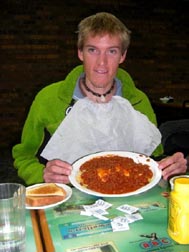 In an athletes diet there are many menu mistakes. Let's just say I have been on the side of the road dry heaving in a race due to poor choices.
In an athletes diet there are many menu mistakes. Let's just say I have been on the side of the road dry heaving in a race due to poor choices.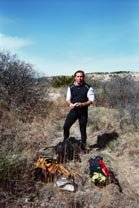 We need to eat a fiber rich and energy rich diet that has protein in it. Now that is not always easy to do!
We need to eat a fiber rich and energy rich diet that has protein in it. Now that is not always easy to do!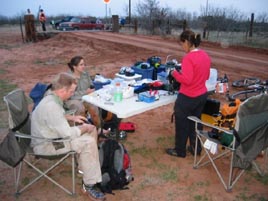 The physical stress of exercise can actually overwhelm the body especially the liver. If it is not being replenished it views this as stress. It starts to hang on to fat for emergencies later. It cannot distinguish between physical (exercise stress) and work or family stress.
The physical stress of exercise can actually overwhelm the body especially the liver. If it is not being replenished it views this as stress. It starts to hang on to fat for emergencies later. It cannot distinguish between physical (exercise stress) and work or family stress.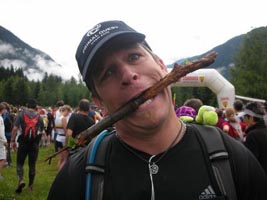 The energy requirements of an athlete must be properly targeted.
The energy requirements of an athlete must be properly targeted.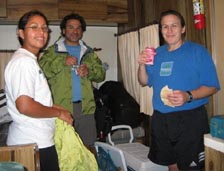 For male athletes, the picture changes even more. For a typical male athlete, the daily calorie requirements are around 3800 calories per day to as much as 8600 calories per day.
For male athletes, the picture changes even more. For a typical male athlete, the daily calorie requirements are around 3800 calories per day to as much as 8600 calories per day.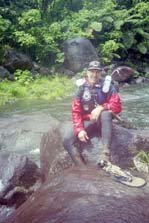 Easy Vegan Recipes
Easy Vegan Recipes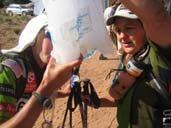 The second major mistake in an athletes diet is the absence of adequate liquids. An athlete must get the right amount of liquids every day to replace the electrolytes that may be lost during daily exercise and exertion.
The second major mistake in an athletes diet is the absence of adequate liquids. An athlete must get the right amount of liquids every day to replace the electrolytes that may be lost during daily exercise and exertion.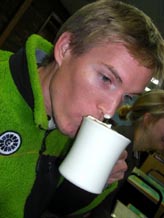 A third mistake in an athletes diet is the sodium level intake. Having too much sodium can be detrimental to the health and the performance of the athlete, while having too little sodium will mean lost electrolytes and thus loss of performance.
A third mistake in an athletes diet is the sodium level intake. Having too much sodium can be detrimental to the health and the performance of the athlete, while having too little sodium will mean lost electrolytes and thus loss of performance.
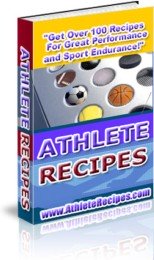
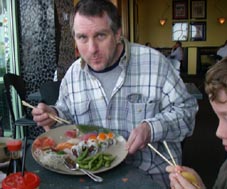 Well at least it was in the past. Hemp protein is taking over as the new player and I am enjoying the benefits of hemp. Both can be mixed in drinks and you will not gain cholesterol like the other types of protein sources. Eating red meat and other meat should be done in moderation and controlled portions for best performance.
Well at least it was in the past. Hemp protein is taking over as the new player and I am enjoying the benefits of hemp. Both can be mixed in drinks and you will not gain cholesterol like the other types of protein sources. Eating red meat and other meat should be done in moderation and controlled portions for best performance.
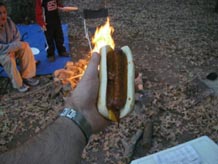 A Purdue study showed in an athletes diet they tend to eat too much of one food group. This raised their body weight 5-20 pounds.
A Purdue study showed in an athletes diet they tend to eat too much of one food group. This raised their body weight 5-20 pounds.





